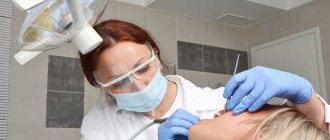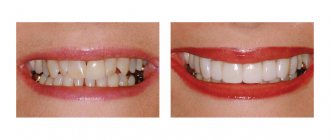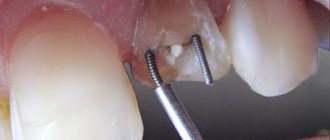Author: Brodsky Sergey Evgenievich Deputy Chief Physician, Candidate of Medical Sciences in the specialties: dentistry and medical microbiology A cyst on the root of a tooth under the crown is one of the fairly common and most dangerous dental diseases. Dentists consider it difficult to treat, and until recently such a diagnosis threatened to remove the tooth, but modern methods of dental treatment provide a fairly high chance of saving it.
Deputy chief physician
Brodsky Sergey Evgenievich
Sign up for a free consultation
+7
What is a tooth root cyst?
A cyst on a tooth under the crown is a benign neoplasm localized at the apex of the tooth root, in its bone tissue. The cystic structure has the appearance of a round cavity, covered from the inside with a fibrous membrane and filled with purulent exudate. First of all, a cyst under the crown of a tooth indicates that the treatment at the stage of preparation for prosthetics was carried out in bad faith, with poor-quality filling of the root canals.
General information about pathology
The very concept of “cyst” or “kystis” translated from Greek means “bubble”. And many patients associate the name of the disease, for example, only with the soft tissues of the body. So what does this mean in dentistry? A cyst under a crown (natural or artificial) is a round-shaped neoplasm located on the root of a tooth, or rather, under it or on the side. The outside of the cyst is covered with a dense sheath of connective tissue - this is how the body limits healthy areas of the jaw bone from the spread of infection. And inside the “bubble” there is a liquid - serous in the early stages and purulent during the long course of the disease. Such a neoplasm is usually benign, but still requires treatment.
REPROSTHETICS WITH ACRYLIC PROSTHETICS - RUB 200,000.
Re-prosthetics with an acrylic bridge on a metal frame (all included) up to 12 units.
Save RUR 30,000. Call now or request a call
Reviews
Despite the fact that a cyst under a denture is a common occurrence in dentistry, this pathology is considered the most insidious due to the difficulty of early diagnosis and the possibility of complications if left untreated.
You can share your experience in treating a cyst and talk about the effectiveness of various drugs and treatment methods on it by leaving a comment on this article.
If you find an error, please select a piece of text and press Ctrl+Enter.
Tags dental crowns tooth cyst
Did you like the article? stay tuned
Previous article
What problems can be solved with preventive orthodontic devices?
Next article
Popular about tooth intussusception
Causes of the disease
Why did a cyst form under the crown? The main reason is a long-term inflammatory process at the roots (periodontitis). If pulpitis, and sometimes even caries and gingivitis, are not treated, then the microbes penetrate deeper into healthy tissue and “get” to the edge of the root - the apex or apex. In the case of pulpitis, the infection from the inside travels along the dental nerve and exits through the apex, infecting the surrounding tissues. In the case of gingivitis, the infection spreads from the outside through the edge of the gum and deep into the ligamentous apparatus - this is the periodontium, which, as it were, “ties” the roots to the bone socket of the jaw. The causes of the inflammatory process may lie in the following:
- incomplete preparation before prosthetics: the tooth could initially already have periodontitis, a cyst, but the dentist did not detect this - if he did not take an x-ray or the picture turned out to be unclear,
- poorly processed and sealed root canals: there are voids and microbes left in them that begin to penetrate into the periodontium,
- if during the passage of the canals the doctor screwed the instrument too deeply: the tip of the file went into the periodontium and brought with it microbes,
- a fragment of the instrument remained in the root canal,
- too much filling compound: the excess is “pressed” into the periodontium,
- inflammation under a crown with a pin or with a stump inlay: a tooth cyst can appear both due to microbes on the pin/inlay, and from displacement, breakage, or too much length of the internal structure under the crown. And also due to the low quality of the filling material under and around the pin,
- cyst at the site of an extracted tooth under a bridge (bridge): may develop due to infection during or after extraction, or if a bone fragment remains in the socket,
- poorly fitting prosthesis
- trauma: strong blow, bruise on the jaw area,
- poor oral hygiene,
- sinusitis, sinusitis: here the infection penetrates through the bloodstream to the roots and provokes inflammation,
- diseases on neighboring teeth,
- weak immunity, chronic diseases of the body.
Difficulties with a prosthesis
The patient’s desire to undergo treatment without removing the crown is natural. But dentists, if the cyst exceeds 0.8 cm, unanimously recommend removing the prosthetic structure.
This recommendation is explained as follows:
- An incision made under the denture may become inflamed. As a rule, a secondary inflammatory process leads to extraction.
- The crown always inhibits the tissue healing process, thereby lengthening the recovery period.
- The doctor does not have the opportunity to properly process the root canals without unsealing them. In dental practice, this process is considered labor-intensive and complex due to the presence of certain difficulties.
Elements that were not only prosthetic, but also reinforced with pins present a particular difficulty in treatment. Removing pins from the canals is quite problematic and risky, but for the success of treatment, this must be done. This means that the crown must first be removed.
Each patient diagnosed with a crown cyst should understand that this formation is quite difficult to treat, and the whole process can take a long time.
One of the features of such treatment is that to eliminate the possibility of complications and the success of the therapy itself, the crown will need to be removed.
Symptoms of the pathological process
What signs can be used to determine that there is a cyst under the crown? Here the guideline is often pain. In the early stages or with a sluggish process, rarely do any patients have pronounced pain - usually it is a weak aching pain, which few people attach importance to. But when a tooth hurts badly and/or there are other signs, then, as a rule, this indicates that the tumor has been under the roots for a long time or that the inflammation is developing rapidly. In general, the cyst can grow in volume over months or years and put more and more pressure on surrounding organs. In this case, even touching the crown with your tongue will be very painful. The following manifestations may also be symptoms of pathology:
- swelling and redness of the gums,
- formation of periostitis (flux or “bumps” on the gum),
- suppuration from under the gums,
- tooth mobility, possible complete loss,
- enlargement of lymph nodes located next to the pathological focus,
- numbness of the lower lip,
- runny nose or heaviness in the sinus due to its inflammation: if sinusitis or sinusitis is caused by an infection that has entered the sinus from a diseased upper tooth,
- weakness, fatigue,
- increase in body temperature.
Read on the topic: pain in a tooth under a crown - what it can mean.
First signs
The initial symptoms of an incipient cyst are inexpressive. While the cystic formation has small parameters, it does not cause concern to a person. There may be slight pain when pressing on the prosthetic tooth , and then only in very rare cases.
When the cystic bladder reaches significant parameters (more than 2 cm), a person exhibits the following symptoms:
- acute pain that always gets worse at night;
- temperature;
- sensitivity to hot, sweet, cold;
- deterioration in general health;
- enlarged lymph nodes in the neck;
- formation of a fistula or gumboil in the gum;
- swelling and numbness of the tissues surrounding the affected tooth;
- darkening of the tooth at the root neck.
Important! The occurrence of even one of the listed symptoms is a reason to immediately contact a dentist and undergo a full examination.
Types of neoplasms under the roots
In the dental classification, there are 3 types of cysts under the crown; let’s look at them in more detail:
- root or radicular: located in the apical part of the root. Appears due to infection during preparation before prosthetics or due to injury,
- primary or keratocyst: most often located near the lower molars - large chewing teeth. It does not appear in any way for a very long time; it is discovered by chance on an x-ray - in the corner of the jaw, on its body or branch. The bone tissue is greatly sparse,
- follicular or tooth-containing: develops from the tooth germ of a canine or wisdom tooth on the upper or lower jaw. Can cause ameloblastoma, a benign tumor
- residual: we can say that this is a secondary cyst, since it develops on the site of a previously poorly removed one,
- paradental or retromolar: most often located between the dystopic wisdom tooth and the roots of the adjacent one, on which the “figure eight” presses.
DENTAL PROSTHESIS ON 4 IMPLANTS - from RUB 140,000.
The price includes all procedures for installing Osstem implants (South Korea), including anesthesia and diagnostics.
Hurry up to sign up for a free consultation and fix your prices.
Call now or request a call
Opening hours: 24 hours a day - seven days a week
Treatment methods in dentistry
What to do if a dental cyst is discovered under the crown? How to save a tooth and avoid extraction? In general, removing a tooth with a cyst in modern dentistry is a last resort when other methods are powerless. Therefore, let's look at tooth-preserving methods of treating pathology.
Conservative methods - antibiotics, depophoresis
At a very early stage, while the neoplasm is very small in size and the tissues are minimally inflamed, you can limit yourself to antibacterial therapy. For example, by introducing an antibiotic into the gum, the tumor should gradually decrease and then disappear. This technique does not always give results, i.e. simply inhibits the development of the pathological process. But the advantage is that there is no need to remove the crown or bridge.
Another therapeutic technique is depophoresis, which has a bactericidal effect. During the treatment process, a special preparation – copper-calcium hydroxide – is placed into the open root canals. Then an electrode is applied (the second one is attached to the patient’s cheek). Within 3-5 minutes, the drug ions spread throughout the root and under it, creating an environment destructive to microbes. On average, you will have to carry out about 5 such procedures, with breaks of 10-14 days. The prosthesis must be removed and fixed after treatment.
Cystectomy or cystotomy
The difference between these techniques is that with a cystectomy, the dental surgeon removes the entire lining of the cyst, and with a cytotomy, only the anterior part. During the operation, a small section of the gum and periosteum is peeled off in the projection of the neoplasm. After which the dentist removes the cyst shell (or one of its walls), then removes all granulations and treats the cavity with hydrogen peroxide. Then two options are possible - either the resulting hole is filled with bone chips (if the cyst was large and the inflammation was not severe), or an iodoform tampon is placed in it. Then the previously detached flap is put in place, sutures are placed on the gums, which will be removed in 6-8 days.
After cystotomy, patients need to undergo another operation 7 days later - replace the tampon with iodoform in the cavity. 3-5 such replacements may occur during the entire course of treatment. Yes, it is traumatic, and recovery takes a long time - but the result is a saved tooth.
Root apex resection
If it is impossible to properly seal the top of the root canal, this part of the root is cut off along with the neoplasm. Just as with cystectomy and cystotomy, the surgeon works through the detached gum and part of the jawbone.
Carrying out hemisection
Hemisection is cutting off the root along with part of the crown. It is carried out on multi-rooted teeth, the root system of which is difficult to access from the side - as a rule, these are chewing teeth or molars (“six”, “seven”, “eight”). But there is a nuance here that under the artificial crown there may be a very small stump - in order not to cause unplanned damage, the dentist works very carefully.
Nowadays, lasers are actively used for such surgical interventions. Which acts very accurately and avoids unnecessary injuries. Also, the laser beam immediately cauterizes the vessels and has a bactericidal effect.
The relevance of traditional methods of treatment
You need to understand that the cyst is located deep under the crown - and none of the home or folk methods will help cope with it, but will only smooth out the manifestations a little. Those. the patient will feel a little better, but the pathology will not go away - it will continue to develop until complications begin. Therefore, the best option is to seek professional dental help. And the use, for example, of saline solution, tinctures of medicinal herbs, various natural oils, and alcohol tinctures is possible only with the permission of the dentist as an addition to the main treatment.
“The crown on the lower five began to wobble a little after 6 years of wearing it. I went to the dentist and thought about removing the tooth and placing an implant right away. But the doctor upset me that it was too early to think about it, because there was a large cyst under the root. I had to remove the tooth along with it anyway. Now I'm waiting for everything to heal. They said that it would take a few months for the bone to recover. In the meantime, I sometimes go for checkups so that there are no problems.”
Glorya_77, review from gidpozubam.ru
Consequences and complications of the disease
Why is a tooth cyst under a crown dangerous? If the pathology is left unattended, then eventually even a slowly developing neoplasm will provoke any of the following complications:
- spread of inflammation to the roots of neighboring teeth: they may change color, begin to hurt, become loose or fall out,
- tooth loss,
- spread of pus to the jaw and soft tissues: this can result in osteomyelitis, abscess, phlegmon, sinusitis, etc.,
- spread of infection throughout the body through the bloodstream: can cause damage to the brain, lungs, liver, kidneys and other organs,
- “degeneration” into a malignant neoplasm,
- sepsis.
Treatment of consequences and complications is much more difficult, longer and more expensive than treatment of a cyst. In many cases, the patient will additionally require rehabilitation1, and, for example, jaw bone augmentation after osteomyelitis. By the way, with this disease you can lose all your teeth in a row.
Complex on 4 OSSTEM implants with delayed loading - 140,000 rubles.
Complex implantation Osstem (South Korea) with delayed loading after 4-6 months.
Doctor's work guarantee - up to 5 years (under an agreement on the provision of medical services) Call now or order a call
Opening hours: 24 hours a day - seven days a week
Expected Result
If the formation is detected at the initial stage and treatment is started on time, the prognosis for cure is favorable. The lack of bone tissue is eliminated through osteogenesis.
When treating a cyst, the safety of the unit depends on its condition. Dentists (if there is any chance) always try to save the tooth.
If, when excision of a cyst, most of the root system is removed along with it, and the remaining fragment does not provide the necessary stability, doctors are forced to remove the tooth.
The video provides additional information on the topic of the article.
How to protect yourself from pathology
To eliminate the possibility of dangerous consequences of prosthetics, incl. the appearance of a cyst under the crown, you need to very carefully choose an orthopedic dentist and a dental therapist. The first one selects the prosthesis, prepares the tooth for its installation and, in fact, ensures the fixation of the crown or bridge. But before that, you need to visit a dentist-therapist who will treat the root canals and carefully seal them. An indicator of the responsibility of doctors is the number of x-rays during the treatment process - at least 5 of them are taken in the process of preparation and prosthetics. They show the smallest voids in the canals and the loose fit of the parts of the prosthesis - if the doctor is not satisfied with the result, he will bring the work to perfection. And the patient will wear dentures without pain and negative consequences.
User Questions
QUESTION My dentist found a cyst in my front tooth under the crown. She says that while she is small, she can be treated with antibiotics. But he said it was better to remove the crown. Why can't you leave her? Alexei
ANSWER Hello, Alexey.
It is likely that your doctor wants to reduce the chewing load on the tooth. To prevent you from accidentally biting something hard or pushing the infection deeper, it is better to remove the tooth from the bite. Another option is to remove the crown. Don't worry, after treatment it will be put back in place. During the treatment process, the tooth will be covered with a temporary filling. 1Epifanov E.A. Medical rehabilitation for diseases and injuries of the maxillofacial area, 2021.
Diagnostics
The only methods that allow one to see the pathology at the initial stage and accurately determine its location and parameters are radiography or orthopantomogram .
If there is a cystic formation, in both types of examination the images will clearly show a dark round (oval) spot with a clear outline of the affected area.











